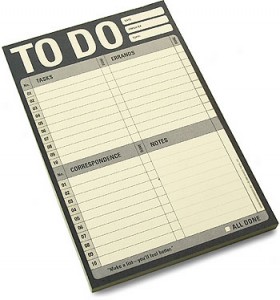 Have you ever had so much to do that you didn’t even know where to start? I know I have. That feeling is crippling. You just sit and think about all of the work you have before you, all of the deadlines looming. Something has to get done, but what?
Have you ever had so much to do that you didn’t even know where to start? I know I have. That feeling is crippling. You just sit and think about all of the work you have before you, all of the deadlines looming. Something has to get done, but what?
How about making a list? I know it sounds so simple, but simply writing down what you have to do can help reset your brain. It’s especially helpful when you understand how to make a to-do list that actually works.
What’s in a list?
Well, everything! From groceries to daily tasks, and all the things we want to do before we die, we humans have lists for everything. We’ll do anything to organize our lives and list making is one way we try to make sense of the worlds around us. Putting our thoughts down in written form helps us feel less overwhelmed. Whether it’s a one off checklist or a daily routine, using lists to structure our thoughts and actions is a proven method for getting shit done.
However, even if we have our list in hand our brain can work against us. Some call it Resistance, but most of recognize this feeling as procrastination. You know, all the times when we’d rather do anything instead of actually work. Can list making actually affect or prevent this from happening?
Lists Done Right
The answer is yes. Making a list can help us go from procrastinating to productive. The best way to get lists to work for you is to create specific tasks, instead of focusing on larger, unclear goals. The latter will echo in your mind and drive you nuts, without any progress being made. On the other hand, the smaller, more focused goals will switch your brain into work mode. That’s because lists work hand – in – hand with a little something known as the Zeigarnik effect.
Maybe you’ve experienced the Zeigarnik effect in your own life. If a goal goes unmet or a task unaddressed said goal will continuously crop up in our mind. There was a time researchers thought that this was the brains way of reminding us of the work we had to do. But, it turns out that it is really our brain asking us to make a plan for how the work will get done. The subconscious mind can’t do that on its own. It needs us to tell it when, how, and where, thereby providing the opportunity to take action. Offering up that opportunity has three main components:
Hone in. What, specifically, do you need to get done? That’s what you need to identify first. It’s called prioritizing. Sometimes that means trimming away less significant tasks. It might also require you to say no to other opportunities and people. But, it’s the only way you’ll actually make progress.
Plan for what’s next. With a focused to-do list in hand, you should work through each item until it’s finished. Remember, the most important tasks come first. It’s okay if you don’t make it through the list in one hour or even one day. When the workday comes to an end, evaluate your to-do list and use it as a guide for what’s next.
Be flexible. There will be times when your list and routine completely fails. That’s okay. Don’t take success or failure personally. Use it as a learning tool. Why didn’t your list go according to plan? If you overbooked yourself, back off the gas pedal and revise your timetable. Just because you write something down doesn’t mean it will be easy to do. You have to be equally committed to the process of making the to-do list as you are to showing up and doing the work to get it done.
Use an app. There are also a variety of to-do list apps that can help you. Different apps for different styles, but you should check out leveraging technology to help you.
Are you a list maker? How do you keep track of your most important tasks?


I have found, over the years, that a physical paper to-do list is the best for me. It also cannot have 84 items on it or I get stuck trying to decide what to work on. A few items that I can get done that day is all I can put on the list to have my most productive day. Then, tomorrow I start with a new list.